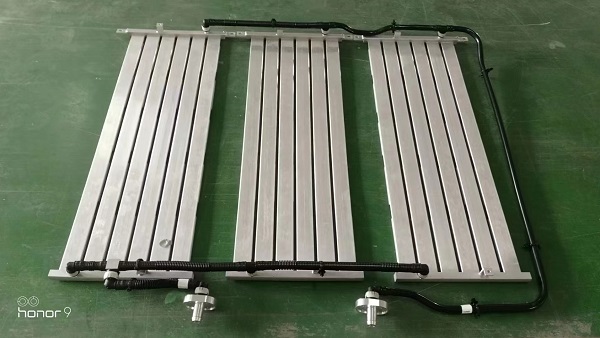

1. Heat dissipation method
1.1 Water cooling
Water-cooling heat dissipation is one of the mainstream heat dissipation methods for motors in the new energy automobile industry. It conducts heat from the motor to the coolant through a circulating water cooling system and releases the heat into the air through the radiator. Water cooling systems usually include water pumps, radiators, water tanks and other components.
1.2 Air cooling
Air cooling is another common cooling method. It uses the wind generated by the rotation of the motor to take the heat away from the surface of the motor through a fan. Air cooling systems are relatively simple and usually only include basic components such as fans and heat sinks.

2. Comparison of advantages
2.1 Advantages of water cooling
Water cooling has the following advantages:
(1) Even heat dissipation, high heat dissipation efficiency and good heat dissipation effect. The water cooling system can achieve uniform heat dissipation of the entire motor through the circulating water cooling system, improving heat dissipation efficiency and heat dissipation effect.
(2) Strong working reliability. The heat dissipation effect of the water cooling system is stable and reliable, not easily affected by the external environment, and can maintain relatively stable heat dissipation performance under various working conditions.
(3) Good weather resistance and little impact on the environment. The water cooling system has good weather resistance, can work normally under harsh environmental conditions, and is not easily affected by extreme environments such as high temperature and low temperature.
(4) The noise is relatively small. The water-cooling system produces relatively little noise during operation, providing better ride comfort.
2.2 Advantages of air cooling
The air cooling method has the following advantages:
(1) The cooling system has a simple structure, few parts and light overall weight. Compared with the water-cooling system, the air-cooling system has a simpler structure and requires fewer parts, which can reduce the weight of the vehicle and improve the energy efficiency of the vehicle.
(2) Low cost. Due to the simple structure of the air cooling system, the cost of required materials and parts is relatively low, thereby reducing the manufacturing cost of the overall cooling system.
(3) After-sales maintenance is less difficult. The maintenance of the air-cooling system is relatively simple, troubleshooting and repair are more convenient, and the time and cost of maintenance and repair are reduced.
3. Comparison of shortcomings
3.1 Disadvantages of water cooling
Water cooling has the following disadvantages:
(1) The cooling system has a complex structure and high safety level requirements. Compared with the air-cooling system, the structure of the water-cooling system is more complex, requiring more components and connecting pipelines, and also has higher safety requirements.
(2) High cost. Since the components and structures required for the water cooling system are relatively complex, the manufacturing cost is relatively high.
(3) After-sales maintenance is difficult. The maintenance and repair of the water cooling system is relatively cumbersome and requires professional technicians, which increases the difficulty and cost of after-sales maintenance.
3.2 Disadvantages of air cooling
The air-cooled heat dissipation method has the following disadvantages:
(1) Uneven heat dissipation, low heat dissipation efficiency, and poor heat dissipation effect. Since the air cooling system relies on the wind generated by the rotation of the motor, the heat dissipation effect is relatively unstable and cannot achieve uniform heat dissipation of the entire motor. The heat dissipation efficiency and effect are relatively low.
(2) Poor working reliability. The air-cooling system is relatively sensitive to the external environment and is greatly affected by extreme environments such as high temperature and low temperature, and its working reliability is relatively poor.
in conclusion:
Comprehensive comparison of the advantages and disadvantages of water cooling and air cooling, the following conclusions can be drawn:
In the new energy automobile industry, water cooling is the mainstream choice. The water-cooling system can provide better heat dissipation and stability through its advantages of uniform heat dissipation, strong working reliability, and good weather resistance, and is suitable for use under various working conditions and environmental conditions. Although the cost of water-cooling systems is higher and after-sales maintenance is more difficult, it is still the first choice for cooling systems in new energy vehicles. The air-cooled heat dissipation method also has certain application prospects in some specific application scenarios due to its advantages such as simple structure, low cost, and easy maintenance.
The future development trend is to further optimize the water cooling system, reduce costs, simplify the structure, and improve heat dissipation efficiency to meet the increasing needs of new energy vehicles for heat dissipation performance. At the same time, with the development and innovation of technology, air cooling systems may have more application opportunities in some special application fields.